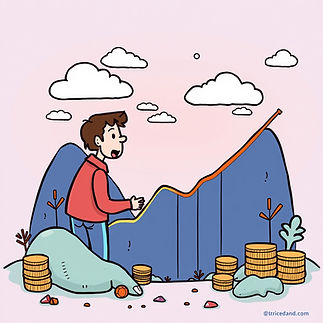Price is what you pay. Value is what you get.

The Three Legs Of Compounding
Compounding stands on three legs:
-
Amount.
-
Time.
-
Rate.
Simple. Unforgiving.
You need all three.
Mess with one, the whole thing tilts.
-
Amount is how much you invest.
-
Time is how long you let it grow.
-
Rate is how fast it grows
That’s the formula. Nothing else matters.

1. Time
Start Early, Stay In
Time multiplies everything.
Start early and your money runs longer.
Start late and you’ve got a short runway.
Time is the quiet partner.
Doesn’t complain. Doesn’t flash. Just works.
The secret?
Don’t interrupt compounding.
Don’t cash out. Don’t panic-sell. Let it ride.
Started late? Don’t panic.
You can do 1 of 2 things:
-
Contribute more
-
Find a better rate
But beware higher returns mean higher risk.
If you're close to retirement, avoid wild bets. You can’t afford a wipeout.
An Example to Illustrate Time:
To retire with £1 million by age 65 at a consistent 10% annual return, your starting point makes a massive difference due to the power of compounding.
-
Person A, who starts investing at age 25, only needs to invest about £188 per month. Time is on their side, and compounding works like a silent partner for four decades.
-
Person B, starting at age 45, must contribute roughly £1,455 per month. They’ve lost two decades of compounding and must make up for it with larger contributions.
-
Person C, beginning at age 60, faces a harsh reality. They’d need to invest £13,650 per month to hit the same target in just 5 years—a goal that’s financially out of reach for most.
The lesson is simple: start early, invest consistently, and let time and compounding do the heavy lifting. Delay, and you’ll pay for it with either much higher contributions or an unreachable finish line.
2. Amount – Add More Fuel
The more you invest, the more that grows.
No money? Make more or save more!
Side hustles:
-
Freelance writing
-
Dog walking
-
Amazon Mechanical Turk
-
Deliveroo, Uber Eats
-
Resell on eBay
-
Babysitting
-
Tutoring
Earn. Stack. Repeat.
Cut ‘wants’:
-
Cancel Prime.
-
Skip takeaway. Four orders a month is £60–£100. Do that for a year, you’ve saved £1,200.
-
Workout at home. YouTube is free.
-
Kill subscriptions you forgot about.
-
Brew coffee at home.
-
Unsubscribe from “just browsing” newsletters.
Small cuts become big amounts.
An Example to Illustrate Amount:
Ben decided to save all the money he could have used for takeaway. Ben usually spends £100 a month on Just Eat. If Ben saves this £1,200 per year (that’s £100 a month) from age 20 and invests it at a 10% annual return, Ben would have approximately £862,686 by age 65.
Even modest savings, when started early and left to compound, can come close to a million. That £25 a week is not nothing!
3. Rate – Risk and Reward
Rate is where things get fast or dangerous.
Want higher returns? You’ll face higher risk.
It’s a trade-off.
A cocaine dealer can double his money in a week.
He can also get shot in the head.
Risk has a gradient:
-
Low Risk: Treasury Bills
-
Medium: Commodities, blue-chip stocks
-
High: Penny stocks, private equity
-
Extreme: Crypto, meme coins, NFTs
-
The higher you climb, the steeper the fall.
Know where you stand. Know what you can handle.
If you want to see your grandkids let alone become a millionaire maybe don't deal drugs!
A tip to always remember: Value investment is the management of risk not returns!
How Long It Takes for Amount to Double
Rule Of 72
Want to know how fast your money doubles?
Divide 72 by your interest rate.
-
72 ÷ 6% = 12 years
-
72 ÷ 10% = 7.2 years
-
72 ÷ 20% = 3.6 years
Low rates mean slow growth.
High rates double faster, but come with danger.
Warren Buffet who is recognised as one of the wisest stock market investor managed to pull it off. 20% a year for more than 50 years. He did not pull it off by travelling 200mph down the fast lane and doing crypto. He did it by being patient. Investing in the boring businesses that stod the test of time.

Compound Calculator
How to Use the Compound Interest Calculator
This tool helps you estimate how much your savings and investments could grow over time using the power of compound interest.
Input Fields:
-
Starting Amount (£):
The money you already have saved or invested. -
Monthly Contribution (£):
The amount you plan to invest every month going forward. -
Time (Years):
How many years you plan to keep investing and let the money grow. -
Annual Interest Rate (%):
The average return you expect to earn each year.
(Example: 7% for index funds, 10% for long-term stock market averages)
What You Get:
After clicking “Calculate”, the tool will show you the Total Future Value the amount you could have by the end of the period you chose.
This helps you:
-
Plan your retirement savings
-
Set FIRE (Financial Independence) goals
-
See the impact of increasing your monthly contribution
-
Understand why time is your greatest investing ally
Tip:
Use different scenarios to experiment:
🔹 What happens if you start 5 years earlier?
🔹 What if you cut £50 in monthly spending and invest it instead?
🔹 How does your outcome change with different interest rates?
Let the calculator guide your strategy and remember:
Start early. Stay consistent. Let compound interest do the work.
Subcribe to our Newsletter
Subcribe to our Newsletter where we discuss saving and investing tips.
.png)